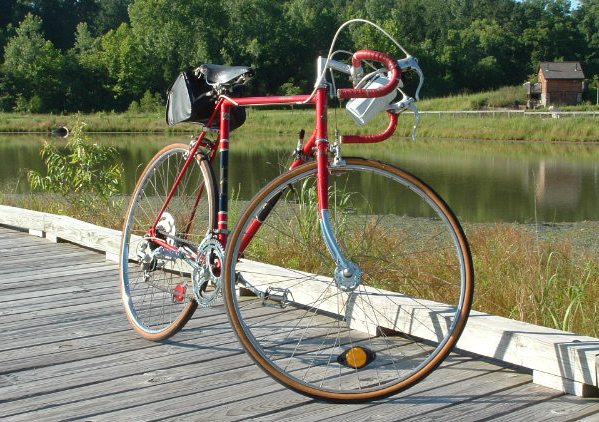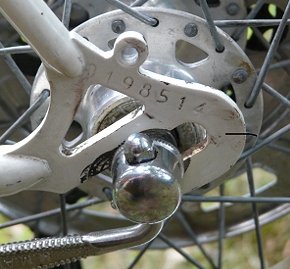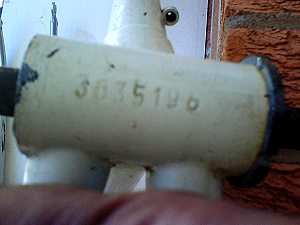|
Raleigh DL-115: The Grand Prix from Gazelle of Holland
|
|---|
| For reasons not exactly known - though likely due to the model's popularity during the Bike Boom - one of the most frequent Raleigh models sold in the U.S. which frequently did not originate from the England plants was the Grand Prix. Though many Nottingham-produced examples were shipped to the States as well, Raleigh's parent company in Holland - Gazelle - produced a surprising quantity of them; enough so that examples are often discussed weekly on classic & vintage internet cycling forums. |

1974 Raleigh (Gazelle) Grand Prix, photo courtesy "gbalke" - Bikeforums.net |
Nevertheless, there exists some confusion about pinpointing the date of manufacture on a Grand Prix, regardless of whether it originated from Gazelle in Holland or the Nottingham plant. For the sake of simplicity, I will exclude the pre-1973 models with cursive downtube lettering for the present time, and concentrate only on models dating from 1973 through 1976 - the frames with Raleigh's 1973-82 italicized font transfers.

1969-1972 Raleigh downtube decal for lightweights/Carlton production |

1973+ Raleigh downtube decal |
|---|
It is easiest to follow these rules when identifying a Grand Prix:
|
RULE #1: The 1974-1976 models are the easiest to date; almost all of these (with exception to some held-over '73 frames) simply follow the standardized serial system developed by Raleigh in mid-1973, whether Gazelle or Nottingham in origin: Seat tube will be stamped with two letters, followed by a series of 6 or 7 numbers - first letter denotes location of manufacture (G for Gazelle, N for Nottingham, W for Worksop plus Nottingham after 1981), second is the month the frame was manufactured, and the first digit will indicate the last number in the standard calendar year - 1974 = 4, 1975 = 5, 1976 = 6. All following digits are the unique (you hope, anyway - remember, this is Raleigh we're talking about) batch number of that particular bike. Nottingham has 6 digits following the year digit; so far, all the Gazelle examples I've seen have only 5. A trivial, inconsequential detail, but an amusing one to quiz your friends with if you have the guts to try this stunt around someone who knows Raleigh serials very well. A well-versed expert can chop you down to reveal a fool - in 10 seconds - if this tidbit constitutes the extent of your knowledge.
|
(truncated for Grand Prix model) Two letters, followed by a series of five (Gazelle) or six (Nottingham) digits:
|
|
RULE #2: The 1973 and earlier frames use a serial system which does follow a pattern - contrary to popular belief - though not an easy one nor quickly decipherable. For those who wish to bother with the details, all the information for this system is mentioned on the "Raleigh Serial Number Systems" portion of the site - the patterns used on these frames are "System 196X," "System 1972," and the one-year 1973 system. For those who want the short answer, continue reading: Any frame that does not have letters in the serial system - such as Gxø***** or Nxø****** - should be considered a 1973 or earlier frame and no earlier than 1973 if it wears the italicized Raleigh block-letter decal kit. All examples with cursive downtube lettering are 1972 or earlier. These serials are generally found on the left dropout, though some examples carry them on the on the BB, and some oddballs have two different serials at both locations. Unless you're a bean counter, this doesn't matter - so long as you don't have any letters in the serial system, it's a '73 frame or earlier, and if you have italicized decals, it is no earlier than '73. There is ONE exception to this: There are some cases of 1973 frames with 1974-dated components on them. These are '73 frames that didn't leave the factory until the following year. To find out if you own such an example or not, simply check the components for date codes - the hubs and derailers, especially. Some of these date codes may be considerably earlier than the frame - ignore them. At this point, you already know whether you have a '73 or a '69-72 frame. What you are looking for are components dated "74," in which case, you have a early '74, with a held-over '73 frame. If you can't find anything dated newer than '73 on a '73/4 frame with italicized decals, you have a '73. Simple as that. |
 Dropout serial Photo courtesy "ianbrettcooper" - Bikeforums.net
|
A note to those trying to ID their Grand Prix from the Raleigh catalogs:
Forget it. The catalogs lie worse than Raleigh's indecipherable serial numbers. Raleigh's components often changed on a whim, especially on the lower-end bikes such as the Grand Prix. As the Grand Prix was Raleigh's sales king in the economy 10-speed lineup, it could, did, can, and will be found with any either Simplex or Huret in '75 and '76, and I dare say that the oddities aren't limited to those components, nor those years. Most of them were spit out of the factory with Simplex. Ditto for fork blades - fork rake and bend location was dependent on what was kicking around in Raleigh's parts bin that day. The Competition and International models appear to be the absolute worst offenders in this respect, but the Grand Prix wasn't excluded from this club.
